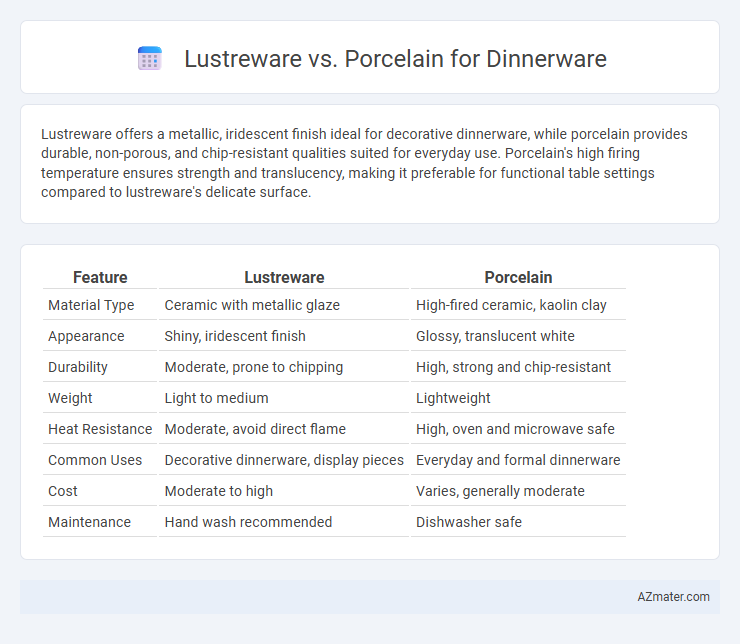Lustreware offers a metallic, iridescent finish ideal for decorative dinnerware, while porcelain provides durable, non-porous, and chip-resistant qualities suited for everyday use. Porcelain's high firing temperature ensures strength and translucency, making it preferable for functional table settings compared to lustreware's delicate surface.
Table of Comparison
| Feature | Lustreware | Porcelain |
|---|---|---|
| Material Type | Ceramic with metallic glaze | High-fired ceramic, kaolin clay |
| Appearance | Shiny, iridescent finish | Glossy, translucent white |
| Durability | Moderate, prone to chipping | High, strong and chip-resistant |
| Weight | Light to medium | Lightweight |
| Heat Resistance | Moderate, avoid direct flame | High, oven and microwave safe |
| Common Uses | Decorative dinnerware, display pieces | Everyday and formal dinnerware |
| Cost | Moderate to high | Varies, generally moderate |
| Maintenance | Hand wash recommended | Dishwasher safe |
Introduction to Lustreware and Porcelain
Lustreware is a type of pottery or porcelain with a metallic glaze that creates a shimmering, iridescent finish, often achieved through the application of metallic oxides and a subsequent firing process. Porcelain is a high-fired, non-porous ceramic known for its strength, translucency, and smooth, white surface, typically made from kaolin clay and fired at temperatures above 1,200degC. Both Lustreware and porcelain serve functional and decorative purposes in dinnerware, with Lustreware prized for its decorative, reflective qualities and porcelain valued for its durability and classic elegance.
Historical Background and Origins
Lustreware, originating in the Middle East during the 9th century, is renowned for its metallic glaze achieved through a complex firing process that reflects Islamic art traditions. Porcelain, first developed in China during the Tang Dynasty (618-907 AD), became synonymous with fine craftsmanship due to its durability and translucent quality, influencing European ceramics from the 18th century onward. Both materials symbolize distinct cultural legacies, with lustreware emphasizing decorative brilliance and porcelain epitomizing elegant functionality.
Material Composition and Manufacturing
Lustreware features a ceramic base coated with a metallic glaze, typically achieved by applying thin layers of metal oxides during firing, resulting in a shiny, iridescent surface. Porcelain is composed of kaolin clay, feldspar, and quartz, fired at high temperatures to create a dense, non-porous, and durable material with a smooth, white finish. Manufacturing lustreware involves complex glazing techniques that require precision in temperature control to achieve the reflective effect, while porcelain production demands high-temperature kiln firing to vitrify the clay body and ensure strength and translucency.
Appearance and Aesthetic Appeal
Lustreware features a distinctive iridescent glaze that reflects light with a shimmering, metallic finish, creating a luxurious and vintage aesthetic ideal for ornate table settings. Porcelain offers a smooth, translucent surface with a pure white or delicately colored finish, known for its timeless elegance and versatility in both casual and formal dining. The choice between lustreware and porcelain hinges on the desired visual impact: lustreware excels in decorative flair, while porcelain provides classic sophistication and subtle beauty.
Durability and Longevity
Lustreware offers a unique metallic finish but is generally less durable than porcelain, as its surface can be prone to chipping and wear over time due to the delicate luster coating. Porcelain is highly regarded for its exceptional durability and resistance to scratches, chips, and thermal shock, making it ideal for daily use and long-term longevity. Choosing porcelain dinnerware ensures a more resilient and lasting option compared to the decorative but fragile lustreware.
Maintenance and Care Requirements
Lustreware requires careful handling due to its delicate metallic glaze, which can wear off with abrasive cleaning or dishwasher use, making hand washing with mild detergents essential. Porcelain boasts high durability and resistance to chipping, allowing for easier maintenance and compatibility with dishwashers and microwaves. Proper care of lustreware preserves its lustrous finish, while porcelain's sturdy nature offers practical, low-maintenance dinnerware for everyday use.
Cost Comparison and Value
Lustreware dinnerware typically offers a more affordable price point compared to porcelain, making it an attractive option for budget-conscious buyers. Porcelain, while often more expensive, provides superior durability and a refined, classic appearance that enhances long-term value. Investing in porcelain dinnerware yields better resistance to chipping and staining, justifying the higher initial cost through extended usability and aesthetic appeal.
Suitability for Everyday Use
Lustreware offers a unique glossy finish that enhances durability but may show wear more quickly with frequent use, making it suitable for decorative or occasional use rather than everyday dining. Porcelain, known for its strength, non-porous surface, and resistance to chipping and staining, is ideal for daily dinnerware due to its ability to withstand frequent washing and heavy use. For households seeking practical, long-lasting dinnerware with ease of maintenance, porcelain remains the preferred choice over lustreware.
Eco-Friendliness and Sustainability
Lustreware and porcelain differ significantly in eco-friendliness, with porcelain being more sustainable due to its durability and ability to withstand high temperatures, reducing the need for frequent replacement. Lustreware often involves metallic glazes containing heavy metals, which can pose environmental hazards during production and disposal. Porcelain's natural materials and longer lifespan make it a preferable choice for sustainable dinnerware focused on minimizing ecological impact.
Choosing the Right Dinnerware for Your Needs
Lustreware offers a reflective, iridescent finish that adds elegance and visual appeal to dinnerware, making it ideal for formal dining settings. Porcelain is renowned for its durability, chip resistance, and versatility, suitable for both everyday use and special occasions. When choosing the right dinnerware, consider factors such as durability, maintenance, design preferences, and the intended use to ensure optimal functionality and style.

Infographic: Lustreware vs Porcelain for Dinnerware
 azmater.com
azmater.com